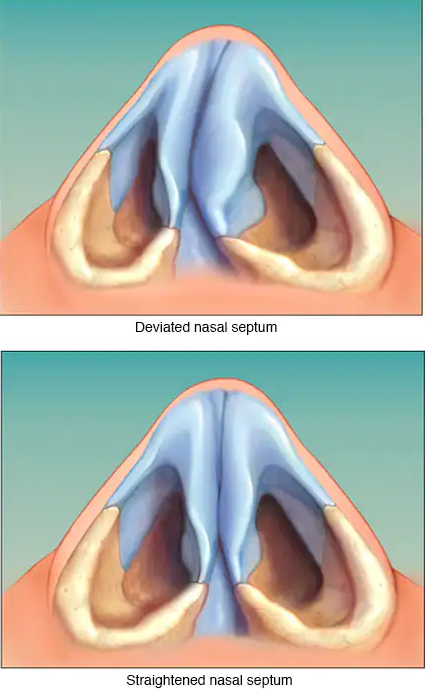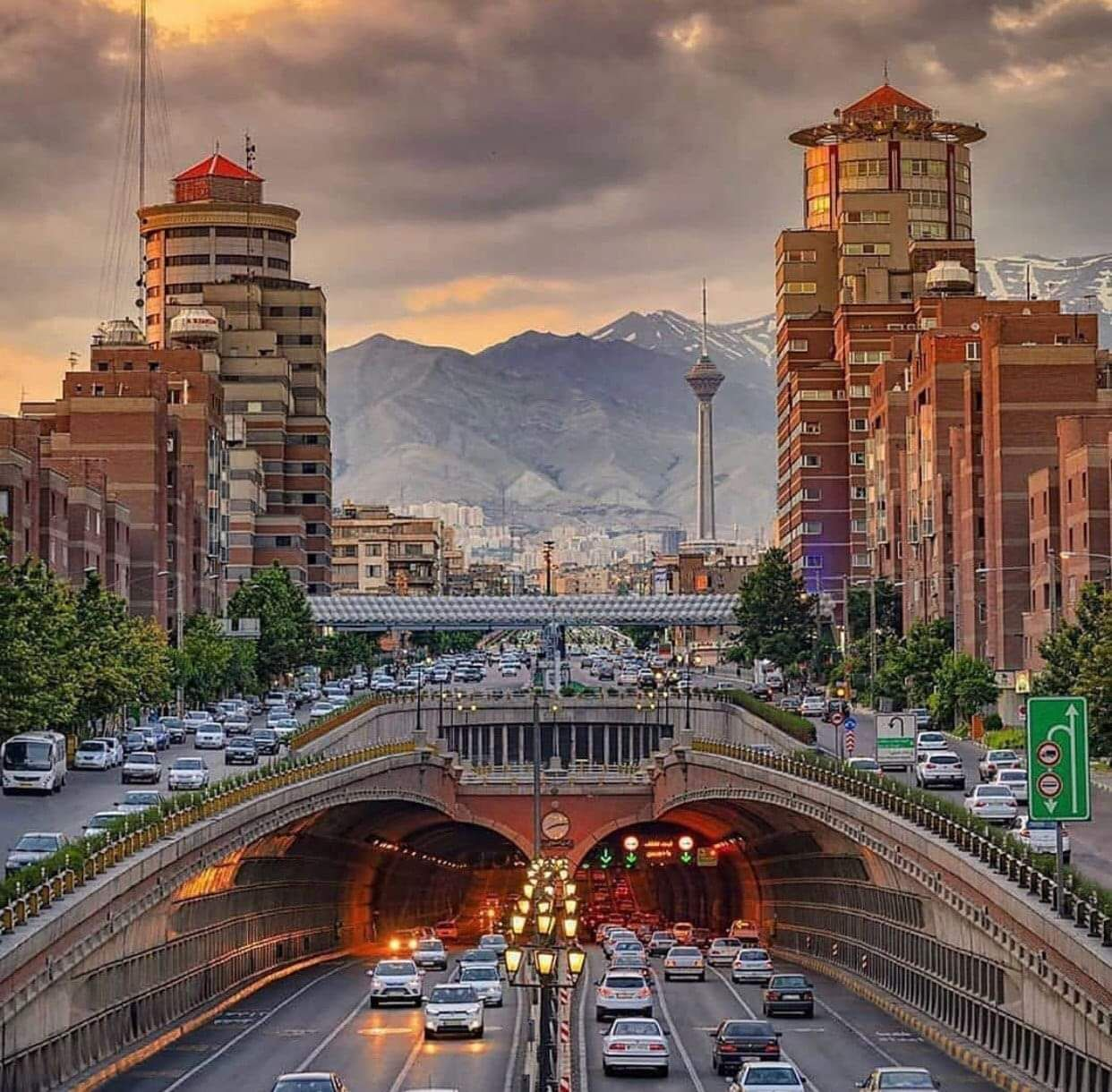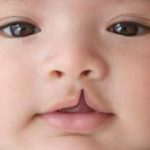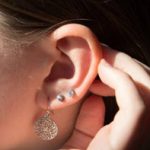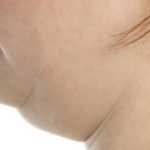Septoplasty (SEP-toe-plas-tee) is a surgical procedure to straighten the bone and cartilage dividing the space between your two nostrils (septum).
When the septum is crooked, it’s known as a deviated septum. A deviated septum can make it harder to breathe through your nose and can increase the risk of sinus infections due to poor drainage.During septoplasty, your nasal septum is repositioned to the middle of your nose. This may require your surgeon to cut and remove parts of your nasal septum before reinserting them in the proper position.Once a septoplasty is healed, you’ll likely find it’s easier to breathe. Your surgeon can discuss what septoplasty can achieve for you.
Why it’s done
A crooked septum is common. But when it’s severe, a deviated septum can block one side of your nose and reduce airflow, causing difficulty breathing through one or both sides of your nose.Septoplasty straightens the nasal septum by trimming, repositioning and replacing cartilage, bone or both.If you experience symptoms — such as difficulty breathing through your nose — that affect your quality of life, you may consider surgery to fix a deviated septum.
As with any major surgery, septoplasty carries risks, such as bleeding, infection and an adverse reaction to the anesthetic. Other possible risks specific to septoplasty include:
- Continued symptoms, such as nasal obstruction
- Excessive bleeding
- A change in the shape of your nose
- A hole in the septum
- Decreased sense of smell
- Clotted blood in the nasal space that has to be drained
- Temporary numbness in the upper gum, teeth or nose
You may need additional surgery to treat some of these complications. You may also need additional surgery if the outcome of septoplasty doesn’t match your expectations. Talk to your doctor about your specific risks before surgery.
How you prepare
Before scheduling septoplasty, you’ll meet with your surgeon to discuss benefits and risks of the surgery. This meeting generally includes:Your medical history. Your doctor will ask about conditions you have or have had, as well as any current medications or supplements that you’re taking.
A physical examination. You’ll have a physical exam, including any relevant tests. The doctor will inspect your skin and the inside and outside of your nose.
Photographs. Someone from your doctor’s office may take photographs of your nose from different angles. Your doctor can use these photos for discussion before septoplasty or for reference during and after surgery.
A discussion of your expectations. You and your doctor should talk about your expectations. He or she will explain what septoplasty can and can’t do for you and what your results might be.
What you can expect
Septoplasty straightens the nasal septum by trimming, repositioning and replacing cartilage or bone. The surgeon works through incisions inside the nose. Occasionally it is necessary to make a small incision between the nostrils.If the nasal bones are crooked and pushing the septum off to one side, it may be necessary to make cuts in the bones of the nose to reposition them. Spreader grafts are small, reinforcing strips of cartilage that can be used to help correct a deviated septum when the problem is along the bridge of the nose. Sometimes these are necessary to effectively straighten the septum.
During the procedure
The procedure may be done with either local or general anesthesia. Which type of anesthesia is used depends on how complex your surgery is, and what you and your surgeon prefer.
- Local anesthesia.This type of anesthesia is limited to your nose. Your doctor injects pain-numbing medication (anesthetic) into your nasal tissues. If you’ll also be sedated, this is done using IV medication. The medication makes you groggy but not fully unconscious.
- General anesthesia.With general anesthesia, you inhale an anesthetic agent or receive an anesthetic through an IV line. This type of anesthesia affects your entire body and induces a temporary state of unconsciousness.
Talk with your doctor beforehand about which kind of anesthesia is best for you.
During surgery, the incision is closed with absorbable suture. Soft silicone splints may be inserted inside each nostril to support the septum. To prevent postoperative bleeding, your doctor may place bandage-like material in your nose (packing).
After surgery, you’re moved to a recovery room, where the staff monitors you and watches for any complications. This procedure is typically performed on an outpatient basis, so you’ll likely be able to go home the same day. You will need someone to drive you home, however.
Results
By three to six months after surgery, your nasal tissues will be relatively stable. It’s still possible that cartilage and tissue may gradually move or reshape over time. Some changes can still occur for up to a year or more after surgery.Most people find that septoplasty improves their symptoms, such as difficulty breathing, that were caused by a deviated septum. The level of improvement you can expect with septoplasty varies by person.Some people find that their symptoms continue even after surgery and opt to undergo a second septoplasty to further refine the nose and septum.
WHAT WE OFFER
- Septoplasty
Clinic and doctor visits, medical tests, medical photography, septoplasty in hospital, post-operative care, medicines*, recovery, and follow-up
- T-Visa Authorization Code
T-visa authorization code. (Note that there is a separate visa fee that the patient must pay when receiving the visa, which it is not part of this package).
- Pick-up & Transfer
Airport pick-up, private transfer from hotel to clinic/hospital and vice versa
- Accommodations
7 nights stay in a three-star to five-star hotel offered which is preferably near the clinic or hospital
- Other Services
24-hour on-call assistance, interpreter, SIM card and internet
Note: The medicines and other aftercare items included in this package are the necessary items prescribed by the surgeon.
Also, the doctors and hotels and clinics which are included in the package are offered by SinoheMedTour to the patient. There may be other doctors whom the patients are considered and the price might be different. Based on a new policy of the Ministry of Foreign Affairs, the citizens of the USA, UK, and Canada are included in different logistic services.
Why Choose Iran for Septoplasty?
Iran is one of the best tourism destinations for septoplasty in several respects.
First, owing to its world-class hospitals and clinics, as well as qualified and skilled physicians, Iran is known for its medical facilities.
Secondly, due to the large number of surgeries, Iran is considered as the capital of rhinoplasty in the world, and this can promise experienced surgeons.
Iran’s currency, on the other hand, has the lowest valuation against the dollar for a variety of reasons; therefore, it is a fantastic way for you to get the finest medical care at a bargain price.
Why SinoheMedTour?
Sinohemdtour is a medical tourism company that has created a forum for recruiting international patients and connecting them with the best Iranian doctors and hospitals.
We provide a free consultation with a team of medical experts as well as a free price estimate.
We link you with Iran’s best doctors and hospitals.
A guide fluent in English or your own language will accompany you during your stay in Iran.
We take care of everything (visa, flight, transfer, accommodation, treatment).
We make every effort to provide you with the best services possible and to assist you with returning home satisfied and happy.


